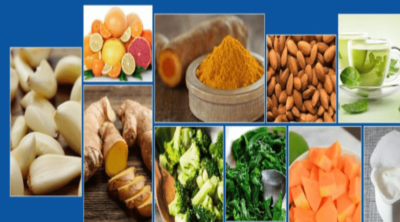
Raw vegetables, fresh fruits, and raw nuts are some of the common foods that can trigger oral allergy syndrome (OAS). Spices like coriander, cumin, aniseed, caraway, and mustard can also cause discomfort among OAS sufferers. The following content has more details.
Did You Know?
Although the symptoms of oral allergy syndrome occur when consuming the offending food, in some cases, simply touching or peeling the problematic food can also cause itching or rash on the exposed area of the skin.
Also referred to as raw food allergy, oral allergy syndrome (OAS) is a condition in which an individual is not comfortable eating uncooked food, be it fruits, vegetables or nuts. OAS sufferers complain about an itchy mouth and throat, and a burning sensation on the lips after consuming these raw foods. Often, this is followed by itchy eyes, runny nose, and sneezing. This allergic response is to certain proteins present in these foods.
People diagnosed with pollen allergy (hay fever) usually develop oral allergy syndrome. Pollen, as we know, is generated from flowers and trees that bloom during spring. On the other hand, grasses produce pollen in summer, whereas, weed pollen is observed in fall. The proteins found in these pollen mimic the proteins contained in fresh fruits, raw vegetables, and nuts. In simple words, proteins from certain raw foods and those present in pollen resemble in structure. As a result, the immune system, upon exposure to pollen, reacts the same way as it would when eating foods that contain these similar proteins. No wonder pollen allergy is highly associated with OAS patients.
Depending upon the type of pollen allergy one experiences, the foods that trigger OAS symptoms are likely to differ. For instance, those allergic to tree pollen are likely to react negatively with apples. However, these individuals will have no issue eating apples if they have only ragweed allergy. Following are the foods that are grouped according to their association with specific pollen allergy.
Birch Tree Pollen Allergy
Ragweed Pollen Allergy
Alder Tree Pollen Allergy
Mugwort Pollen Allergy
Foods that have been linked to any of the aforementioned types of pollen allergy:
It is not necessary that having a specific type of pollen allergy means one is sensitive to all foods in that group. For instance, if one is allergic to birch tree pollen, he/she may develop sensitivity to just 2 to 3 foods in that group. It is to be noted that those who are allergic to specific types of pollen may eventually become allergic to other types of plant pollen as well. Meaning, the initial allergy to specific foods in a particular group may eventually extend to foods in other groups too.
Prevention
Excluding these foods from one’s diet is the best option to prevent OAS symptoms. However, considering this huge list of foods, it may not be possible to avoid these foods always. In such circumstances, one should ensure that these vegetables, fruits, and nuts are well-cooked before consumption. Cooking deactivates the proteins that cause allergic response. So, eating food that is cooked properly is unlikely to trigger any OAS symptoms. Giving microwaved or tinned (canned) foods to OAS patients is also usually not a cause for concern, as the heat or processing involved in canning foods kills the allergenic components. Peeling fruits like apples may help to significantly reduce OAS risk, as most of the allergens are present in the skin.
Caution
Although cooking helps destroy the allergens, there are few exceptions. So, despite cooking celery, spices, roasting nuts or seeds, or having a herbal tea like chamomile, it is unlikely to nullify their allergy-causing potential. The rule that ‘peeling the skin of a fruit removes most of the allergens’ is also not applicable to all fruits. Therefore, OAS symptoms may occur despite eating a fruit that has been peeled.
It is observed that in a majority of cases, OAS patients tend to experience allergy to only a few of these foods. Getting diagnosed with OAS does not mean that one should switch over to meat products and discard these nutritious foods. In fact, following a low-plant diet can make one vulnerable to a wide range of health problems. All that is needed is to identify the set of problematic foods and choose the ones that are comfortable for consumption. Also, cooking the food properly before consumption, in most cases, does eliminate the chances of experiencing any OAS symptoms. Therefore, follow diet restrictions, but make sure it provides adequate nutrition for overall well-being.
Disclaimer: This NutriNeat article is for informative purposes only. Please consult your physician/nutritionist for case-specific advice.
